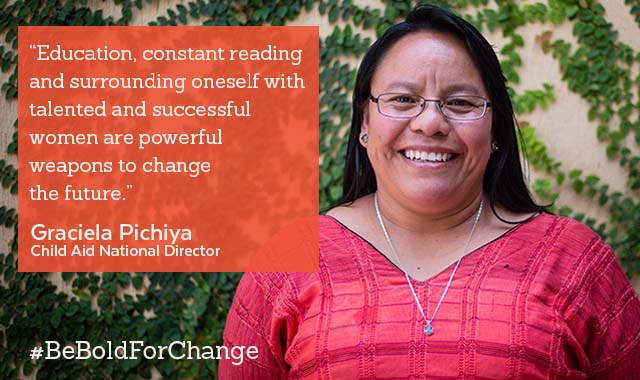
By Graciela Landa Pichiya, Child Aid National Director
Last Thursday evening I was walking in Antigua, Guatemala, and came across a young indigenous girl, no more than 3 years old, selling handbags in a Mexican restaurant. The purses had been hung around her neck. The girl was not old enough to speak clearly, and two meters away a young woman stood watching over her. It was obvious to me that this child was a prop meant to appeal to potential buyers. I wanted so badly for this little girl to be home jumping on her bed or running around playing and screaming with joy. Nearly an hour later, I saw the child again, but this time she was kneeling on the sidewalk with her elbows propped on the top step leading to the doors of yet another restaurant. She was cradling her jaw in her hands. She still had handbags looped around her neck. I saw the indifference of people walking past this girl, and I felt pain, impotence and anger. What will this young girl’s future look like? Will she have a chance to go to school? To learn to read? To hold her strong neck up with pride?
My biggest fear regarding girls and education is that after the pandemic fewer girls than boys will return to school because girls must work to provide money for their homes, or perhaps they have lost one or both parents to COVID and must take on adult responsibilities at a very young age.
I worry for adolescent girls who suffered from sexual abuse during the pandemic and have become mothers, preventing them from continuing on with school because they must care for a baby. These factors increase school dropout rates, boost illiteracy rates, malnutrition and overall poverty, especially in rural areas and indigenous populations.
We should demand that the Guatemalan government respect the human rights of women and strengthen health, education and justice institutions that will support the creative initiative of many women who, when faced with the harsh facts of life here, reinvent their way of surviving and thriving.
I call upon the Guatemalan Ministry of Education to adopt educational reform and the National Base Curriculum that is multiculturally sensitive and takes into consideration the values, language, culture, customs and traditions of the communities of the young students in its care.
I have every reason to be hopeful about the futures of girls and women in my country.
I have evidence that women in Guatemala today are taking giant steps to position themselves as leaders in spaces and jobs where men have previously dominated. I see more female teachers in our schools and more female leaders in non-profit organizations working in Guatemala.
I also greatly admire strong women such as Claudia Paz y Paz, Guatemala’s first attorney general and Erika Lorena Aifán, judge of the High Risk Court, who are two of 13 Guatemalans who must live in exile due to their dogged prosecution of government corruption. I am proud of Otilia Lux de Coti, a human rights and indigenous peoples’ activist who encourages indigenous women and girls to be educated and trained to occupy leadership positions in my country.
My experiences make it clear to me that education, constant reading and surrounding oneself with talented and successful women are powerful weapons to change the future. I remain hopeful that thousands of girls will continue studying, graduate from universities, develop leadership skills and grab the bright opportunities women should have in Guatemala and around the world.